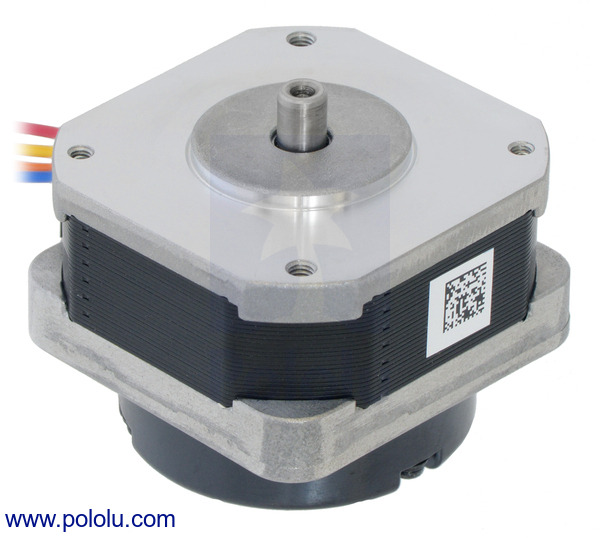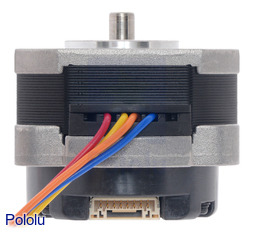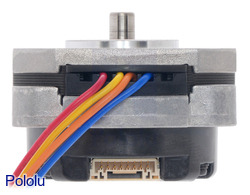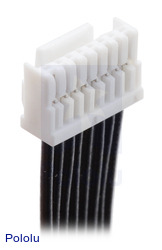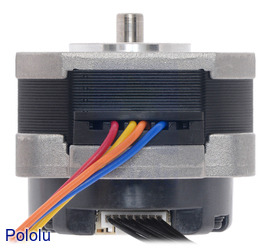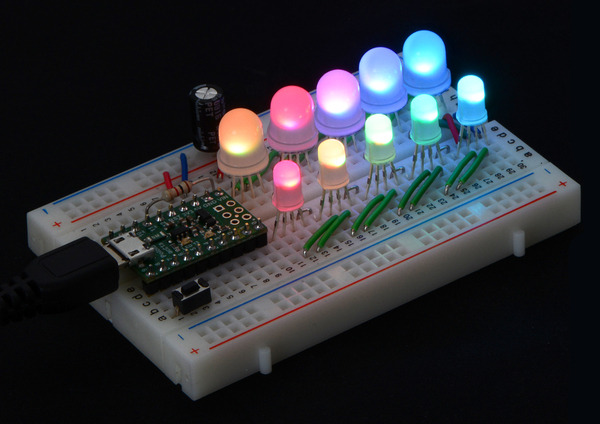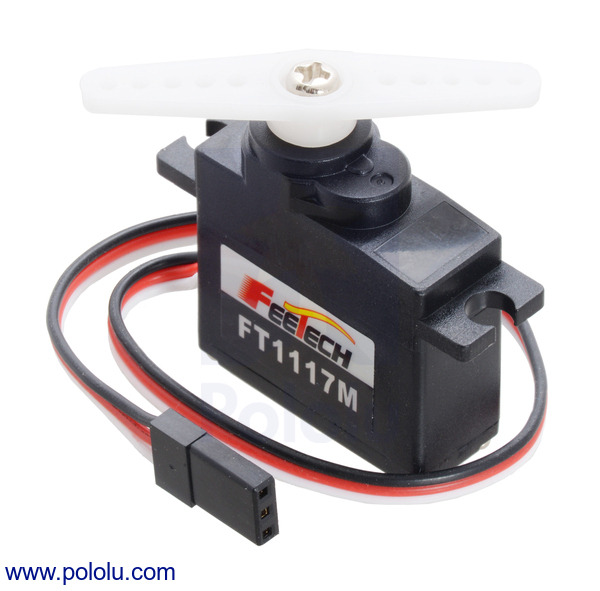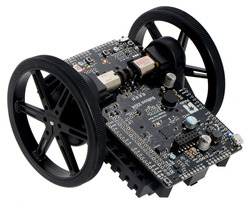Pololu Blog »
Pololu Blog (Page 29)
Welcome to the Pololu Blog, where we provide updates about what we and our customers are doing and thinking about. This blog used to be Pololu president Jan Malášek’s Engage Your Brain blog; you can view just those posts here.
Popular tags: community projects new products raspberry pi arduino more…
Sanyo pancake stepper motors with encoders
We are now offering two new NEMA 17-size pancake bipolar stepper motors from Sanyo, each featuring an integrated high-resolution quadrature encoder and home channel for absolute positioning.
| Stepper motor | Steps per revolution | Current rating (per coil) | Voltage rating | Resistance (per coil) | Holding torque |
|---|---|---|---|---|---|
| #2279 42×31.5mm | 200 | 1 A | 5.4 V | 5.4 Ω | 1.9 kg-cm (26 oz-in) |
| #2278 42×24.5mm | 200 | 1 A | 3.5 V | 3.5 Ω | 800 g-cm (12 oz-in) |
|
|
The integrated quadrature encoder operates from 5 V and has a resolution of 1000 P/R, which allows for 4000 counts per revolution (CPR) of the output shaft when counting both edges (i.e. rising and falling) of both channels (i.e. A and B). In addition to the A and B channel outputs, the encoder has a home channel, Z, that pulses once per revolution and can be used for absolute positioning. The encoder also has outputs for the inverse of A, B, and Z. A 15 cm (6″) encoder cable is included.
|
|
|
New 12V 1A wall power adapter
We’ve replaced our original 12 V 1 A wall power adapter with a lighter, smaller version. This UL-listed 12 W, “wall wart”-style switching power adapter supplies up to 1 A at a regulated 12 VDC. The AC adapter works with input voltages of 100 to 240 VAC and has a 1.5 m (5 ft) DC power cord that is terminated by a center-positive, 5.5 × 2.1 mm barrel connector.
Free Circuit Cellar magazine April 2017
 |
Get a FREE copy of Circuit Cellar magazine’s April 2017 issue issue with your order, while supplies last. To get your free issue, enter the coupon code CIRCUIT0417 to your shopping cart, or click the link. The magazine will add 6 ounces to your order weight when calculating your shipping options.
For back issues and more information, see our free Circuit Cellar magazine offers.
Addressable through-hole RGB LEDs are back
We’re happy to announce that our previously discontinued addressable through-hole RGB LEDs are once again part of our catalog and in stock! While these might look like ordinary RGB LEDs, each one contains its own integrated WS2811 LED driver that lets you chain them together and individually control them all with a single digital output from a microcontroller. The interface is very similar to that of our SK6812-based LED strips, so there is a variety of sample code available for the Arduino, AVR, and mbed microcontroller platforms.
The LEDs are available in two sizes: 5 mm and 8 mm.
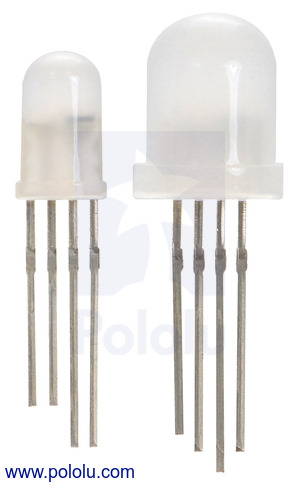 |
Two different sizes of addressable RGB LED. From left to right, their diameters are: 5 mm (#2535) and 8 mm (#2536). |
|---|
MechWarfare robot
Forum member jwatte posted about a robot he made for the RoboGames MechWarfare 2017 competition. The goal is to build a walking robot that tries to hit an opponent’s pressure sensors with airsoft pellets or melee weapons. The robots walk around in a scaled-down cityscape field. Autonomous operation and teleoperation are allowed, but teleoperators must view the field from cameras mounted on the robot.
 |
The mech uses a few Pololu voltage regulators: a 3.3 V, 1 A step-down regulator D24V10F3 powers a Xbee-Pro 900 XSC S3B wireless transciever and the laser pointer, a 6 V, 500 mA step-down voltage regulator D24V5F6 powers an OpenCM 9.04A robot logic board, and a adjustable step-down regulator D24V6ALV powers a 5.8 GHz wireless camera. A 250:1 Micro Metal Gearmotor LP 6V drives the plastic BB agitator that feeds the airsoft gun. The wiring harnesses used a lot of our pre-crimped wires.
For more details including a system block diagram see the forum post.
FEETECH Mini Servo FT1117M
We added the FEETECH Mini Servo FT1117M to our expanding RC servo selection.This miniature-sized servo has a stall torque of 50 oz-in (3.5 kg-cm) and a speed of 0.11 sec/60° at 6 V. The pinion gear is plastic, but the rest of the gear train consists of all metal gears, allowing this servo to deliver the kind of speed and torque typically associated with larger servos.
Comparison to the Power HD 1711MG mini servo
This servo is a lower-cost alternative to the 1711MG from Power HD, which has nearly identical dimensions and performance. The two servos should be generally interchangeable for most applications. The picture below shows both the FT1117M and the 1711MG side by side:
 |
Expect more new FEETECH servos in the coming weeks!
Video: Raspberry Pi robot with the Romi chassis
A few weeks ago I posted a tutorial on building a Raspberry Pi robot with the Romi 32U4 Control Board and Romi Chassis. Now we have a short video of the robot in action! For the full tutorial, see my earlier post.
How to make a Balboa robot balance, part 5: popping up and driving around
This is the fifth and final post in a series about how to make a Balboa 32U4 robot balance. In earlier posts I covered everything you need to get the robot balancing. In this post I will talk about how to get your Balboa to perform some fun and challenging maneuvers.
If you have been following along, you should now have your robot using its inertial sensors, motors, and encoders together to balance in place. Now it’s time to get it moving! Our first challenge will be to get it to “pop up” from a resting position into a balancing position. Then I will show how you can get the Balboa to drive around while balancing. Continued…
Ten-Tec 1254 Receiver Display Upgrade Kit
 |
Edward Cholakian (call sign KB1OIE) makes and sells a Ten-Tec 1254 Receiver Display Upgrade Kit that is designed to upgrade a Ten-Tec 1254 shortwave radio receiver.
One of the main features of the kit is that it provides a backlit 2×20 character LCD to replace the receiver’s original 5-digit 7-segment display, allowing much more information to be shown. The kit includes a clear plastic window to replace the receiver’s original smoked dark plastic window, and a black plastic display mask. Edward gets both of these pieces made using our custom laser-cutting service.
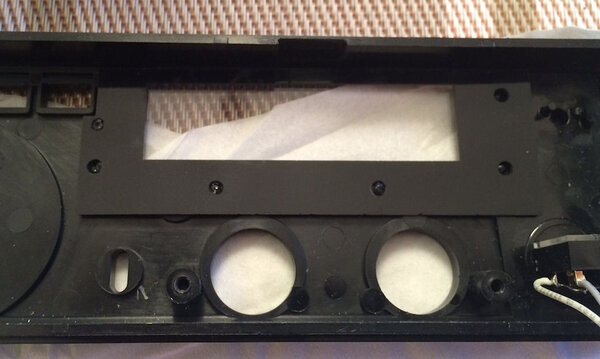 |
Two laser-cut pieces, a clear window and black display mask, shown on top of the Ten-Tec 1254 receiver’s original face plate. |
|---|
 |
Ten-Tec 1254 receiver with Edward Cholakian’s display upgrade kit installed. |
|---|
The display/control board in the kit uses the P-Star 25K50 Micro as its processor. Edward, a consulting engineer who designs embedded hardware and firmware, told us that he chose the P-Star because he was already using a Microchip processor similar to the P-Star’s PIC18F25K50 in one of his previous designs, and it was more economical to buy the P-Star than to hand-assemble his own board. He said the P-Star’s cross-platform USB firmware upgrade software was also a plus since his own bootloading software does not support Linux and macOS.
The kit comes with software for Windows that can control the receiver over USB. The software provides a graphical user interface and uses WinUSB to talk to the P-Star’s native USB interface.
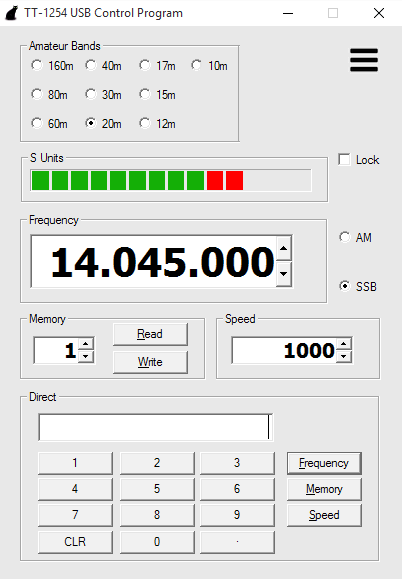 |
USB control program for the Ten-Tec 1254 Receiver Display Upgrade Kit |
|---|
For more information, see the Ten-Tec 1254 Receiver Display Upgrade Kit page.
RoboClaw 2x60A Motor Controller (V6)
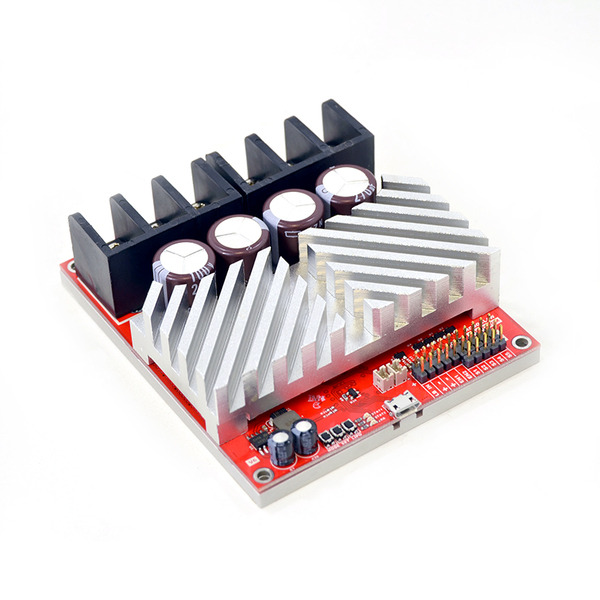 |
The RoboClaw 2x60A motor controller (V5) we’ve been carrying has been replaced by the new RoboClaw 2x60A Motor Controller (V6). This powerful motor controller can drive two brushed DC motors with 60 A continuously at voltages from 6 V to 34 V, and it allows for peak currents up to 120 A. Version six adds a protective aluminum plate to the board bottom and ports for connecting optional cooling fans that are controlled based on the board temperature.
 |
RoboClaw 2×60A Motor Controller (V6) and RoboClaw 2×60AHV Motor Controller (60VDC), bottom view. |
|---|
The RoboClaw motor controllers from Ion Motion Control can control a pair of brushed DC motors using USB serial, TTL serial, RC, or analog inputs. Integrated dual quadrature decoders make it easy to create a closed-loop speed control system, or analog feedback can be used for position control.
For more information, see the product page.
